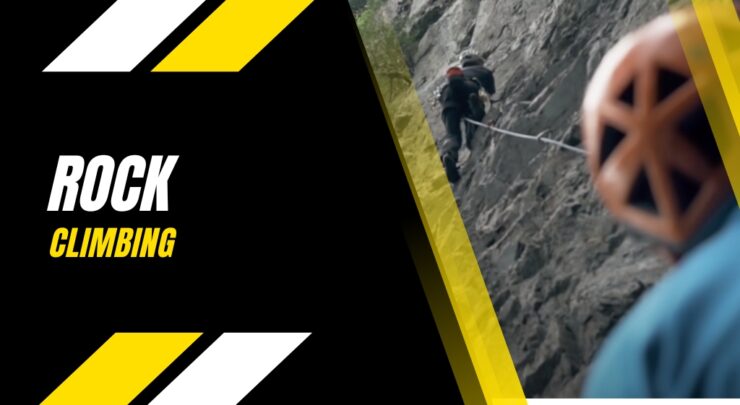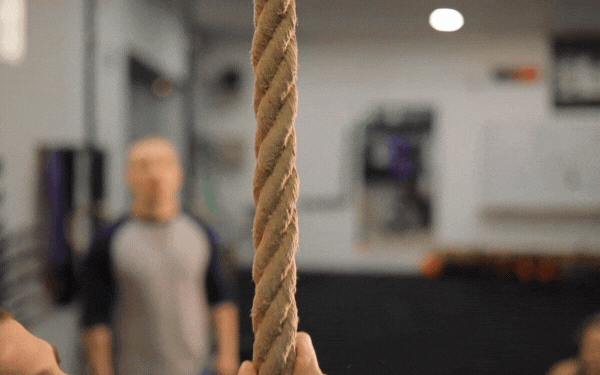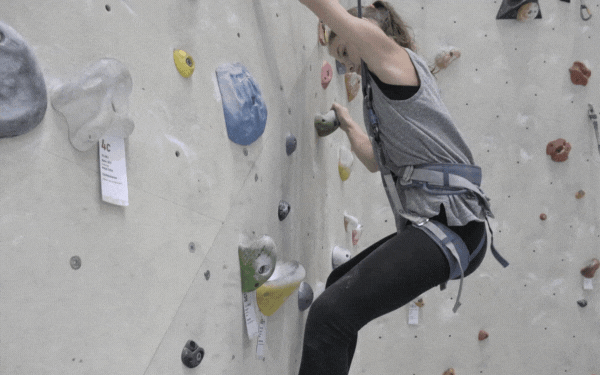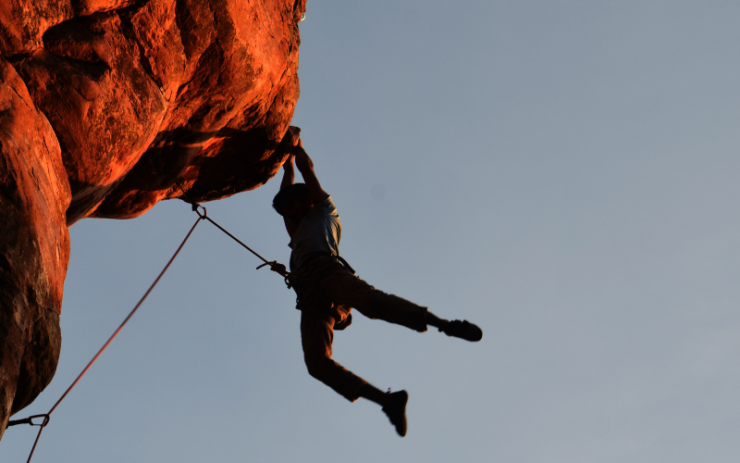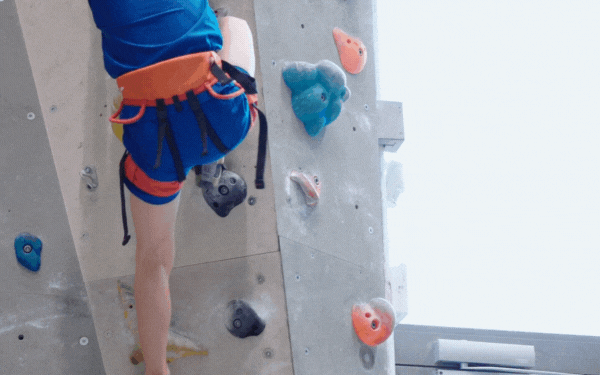Do you want to learn about the various types of rock climbing? If yes, this article is for you. Before we dive right into that, we are first going to a close look at the sport to see what it is all about.
As you probably know, rock climbing is an exciting activity that challenges our minds and bodies, pushes us out of our comfort zones, and helps us build self-discipline and endurance.
That is why more and more people are getting into it every day. That said, rock climbing is by no means a walk in the park.
The reason for this is that climbers need to master proven climbing techniques, learn how to use rock climbing equipment, and so on to become proficient climbers.
Contents
What Exactly is Rock Climbing?
Rock climbing is a rewarding activity that involves climbing rock surfaces with the aid of special gear and equipment. The goal of the activity is to reach the summit or top of the rock.
Just like any other outdoor activity, rock climbing is physically demanding, and it requires mental toughness, agility, focus, flexibility, physical strength, and quick thinking.
As you probably know, all rocks aren’t the same. While some are easy to climb on, others are difficult and require special skills, equipment, and technique to climb.For this reason, many people train in rock climbing in gyms, such as LakeNonaPerformanceClub.
Rock climbing gyms provide instruction on various climbing techniques, such as handholds, footwork, body positioning, and balance. Learning proper techniques is essential for efficiency, safety, and progress in climbing.
Climbers learn how to tie essential knots, like the figure-eight knot and the double fisherman’s knot, to secure themselves to the climbing rope and attach it to the harness. They also learn about belaying, the process of controlling the rope to protect a climber in case of a fall. Moreover, they develop the ability to “read” climbing routes, analyzing the holds and movement required to complete a climb successfully.
Aside from physical strength, rock climbing offers numerous psychological benefits that can positively impact a person’s mental well-being and overall quality of life. The focus required to navigate routes, the physical exertion, and the thrill of overcoming challenges can help individuals temporarily escape from daily stressors and promote relaxation.
Moreover, integrating mind and body can foster a deeper sense of self-awareness and body appreciation. Climbing encourages individuals to set specific goals, such as reaching a particular climbing grade or conquering a difficult route. Working towards and achieving these goals can provide a sense of purpose and motivation.
Types of Rock Climbing
In the eyes of a novice climber, all types of rock climbing may look the same. But that is far from the truth because there is a stiff contrast between the different types of rocks.
In this section, we are going to be looking at some popular types of rock climbing.
01. Aid climbing
This is a popular rock climbing technique that involves the use of equipment that can be attached to the rock surface.
This style of climbing is usually done on the challenging part of a route where it is impossible to pull on the rock.
This climbing style is perfect for completing a new route that hasn’t been explored before. In fact, most routes in El Capitan were first charted by climbers using this climbing style.
The obvious reason why this style is used, especially when exploring new routes, is that it is safe and doesn’t require climbers to pull themselves.
02. Free Climbing
This a yet another popular type of rock climbing that is perfect for completing rock climbing routes that aren’t too challenging and give climbers the room to pull themselves up without the need for special devices to progress upwards.
But of course, ropes and a few other gears are used to protect climbers in case they fall or lose their grip.
Keep in mind that the rope does not aid the climbing process but helps protect them if they fall.
Climbers using this technique have to rely totally on their physical strength and agility to complete a route, as no equipment is used to aid the climbing process.
03. Roped climbing
Most greenhorn rock climbers use this climbing style in the outdoors, as well as in the gym, as it is safe and prevents them from falling to the ground if they lose their grip.
As you likely know, the rope doesn’t help climbers go higher; it only helps to keep them safe.
Using this technique is somewhat easy as pre-existing anchors, which the rope will run through are present in a lot of climbing routes.
Here is how the rope is used when climbing in outdoors.
A climber will attach one end of the rope to himself and start ascending. The other end of the rope will be attached to another person.
The job of the second person is to hold on to the excess rope as the climber slowly ascends.
04. Unroped climbing
This is the opposite of roped climbing, as it doesn’t involve the use of ropes and other climbing gears. One amazing thing about this type of climbing is that it gives climbers the freedom to climb any way they see fit.
Unroped climbers do not have to worry about climbing knots, ropes, clippings, and so on. It is just rock and them.
In other, for climbers to climb without ropes, they need to be able to unburden themselves of heavy loads or high-end gears.
Below are the three main types of unroped climbing.
⦁ Bouldering
⦁ Free solo climbing
⦁ Deepwater soloing
Bouldering routes usually involve steeply overhanging and powerful moves.
You need core strength, balance, and delicate footwork to overcome boulder problems involving thin-hold slab climbing and smears.
However, some shoes for bouldering are not explicitly designed as bouldering shoes.
In the same way, free solo climbing and deepwater soloing require specialized gear and footwear.
Free solo climbing is a form where individuals ascend rock walls or cliffs without using ropes, harnesses, or any protective equipment.
Hence, shoes must have a snug fit and sticky rubber soles that provide an excellent grip on the rock surface.
Wearing the right shoes can make your climbing experience safer. Check here to learn more.
Other Types of Climbing
While there are some popular rock-climbing types, like some of the ones listed above, there are others that are somewhat different, and can’t really be labeled as rock climbing. Below are a few of them.
01. Ice climbing
As the name implies, this involves climbing ice instead of rocks. They use special shoes that can easily dig into the ice. Also, they use ice picks to climb the ice instead of their hands.
They protect themselves by placing ice screws into certain solid parts of the ice and attaching ropes to them.
Via Ferrata
Via Ferrata is an Italian word that means- *iron way*. It is perfect for greenhorn climbers who want to get a feel of what it feels like to climb a mountain.
To ensure that the climbing route is safe and easy to climb, metal rungs, which act as a ladder, are attached to the rock.
Outdoor Climbing
Outdoor climbing is the real deal. It involves climbing rocks outdoors. Outdoor rock climbing is usually done on dry sunny days; the holds produce the best grip.
Yes, outdoor climbers can also climb rocks at night and in adverse weather conditions, but the risks involved during these conditions are astronomical.
That is why it is advised that only experienced climbers should climb rocks during adverse conditions.
Indoor Climbing
As the name suggests, indoor climbing is done indoors. The climbing takes place on specially built walls, which are usually made from wood and other sturdy materials. To aid climbing holds are installed.
Indoor walls are an excellent training ground for people who are new to rock climbing or those trying to master the basics.
The reason for this isn’t just because it is safe but also shields climbers from the elements.
Even more, indoor wall climbing centers have staff that newbies can train along with and expert climbers can learn a few things from.
One exciting thing about indoor walls is that the climbing route can be rearranged to keep things interesting.
Benefits of Rock Climbing
Rock climbing provides a comprehensive workout, engaging nearly every muscle group for a total-body fitness experience. It enhances both muscular strength and endurance through repetitive movements and isometric contractions.
Climbing also promotes cardiovascular fitness by elevating heart rate during sessions. As climbers progress, they develop better flexibility and balance. Mentally, climbing demands intense focus, sharp problem-solving skills, and cognitive improvement.
The social aspect of climbing, whether done with friends or in a gym, fosters a sense of community and enhances mood. Goal setting and achievement are integral, boosting self-esteem and motivation. Outdoor climbing offers a connection with nature and the enjoyment of the great outdoors.
The benefits associated with rock climbing are endless. Below are a few of them.
01. Flexibility
Rock climbing is a great way to improve flexibility and overall fitness. If you were stiff and inflexible when you first started rock climbing, you will be shocked to see yourself reaching unimaginable hold, just after a few weeks of training.
02. Balance
To climb a rock, you have to engage your core muscles and abdominals. Doing this continuously will help improve your balance and give you better control over each muscle in your body.
And as you transition into an expert climber, you will be able to remain stable and balanced even in the most uncomfortable position.
03. Improved grip strength
Rock climbing also helps to improve your grip strength and make you better at the sport. Even more, it will help you lift heavy weights and hold on to your grocery bags a little while longer.
04. Reduce stress
Rock climbing is undoubtedly one of the most effective ways to reduce stress.
You pushing yourself to the limit and exerting yourself will trigger the production of endorphins, which help reduce stress and make you feel better.
05. Endurance and Stamina
Rock climbing forces you to dig deep and do whatever it takes to go past your limit.
In fact, you will be shocked to see yourself mustering the strength to get yourself out of a tricky spot or hold on tighter and longer.
The more you climb, the better you will get at enduring and thinking out of the box.
06. Problem-solving
Rock climbing is an art. It isn’t just something that can be done by anyone.
For climbers to scale through the challenge they encounter when climbing, they have to think deeply and figure out ways to scale through any problem that comes their way.
And if you can do this consistently, you will become a master problem-solver.
Dos and Don’ts of Rock Climbing
Mistakes are inevitable, especially when it comes to rock climbing. Whether you are just starting out or a pro climber, there are some mistakes you must stop making to have a better climbing experience.
Also, there are a handful of things you should give try to boost your performance and skill level.
Do-support others
See, rock climbing is a team sport, so don’t think about only yourself and start brainstorming ways to get to the top first. Instead, work with other climbers.
Offer words of encouragement, help ensure that their gear is well placed, and most importantly, treat them with respect.
Don’t – Don’t ruin the fun for other climbers
If you see a climber fail a particular section of a route multiple times and you know how to move past it, you may feel the urge to offer advice to the falling climber.
Do whatever it takes to resist that urge and keep your mouth shut. You see, when you tell him or her, the right way to scale through a boulder problem, you are indirectly ruining the fun for them.
Do – Focus on your technique
It is easy to assume that acquiring more power will make it easier to climb faster and perform better.
But that is far from the truth, the technique is far more important because it not only builds your strength to become a decorated climber, but it also gives you confidence.
Don’t -Training every day
Regardless of how much time you train, you aren’t going to be a better climber overnight. So take things gradually, your body isn’t a machine. It needs rest to perform well.
Which rock climbing is perfect for kids?
Rock climbing offers a plethora of benefits, not just to adults, but also to kids.
You see, as a kid learns to climb, he will come to understand the importance of concentration, focus, and quick thinking.
Granted, outdoor climbing is great for kids, as they can interact with nature, but it is wise that they start with indoor climbing as it is safer and also fun to climb.
Even more, there are experienced guides and supervisors in indoor climbing centers that can help kids master basic climbing techniques and build confidence.
Which rock climbing is perfect for women?
In the past, rock climbing was a sport dominated by men. The same cannot be said right now as there are a lot of awesome female climbers with jaw-dropping techniques and amazing skills.
Professional female climbers engage in everything from free solo climbing, trad climbing, top-roping, and deep water soloing to alpine climbing.
That said, a huge percentage of female climbers engage in bouldering as it isn’t too challenging and has a lot of physical and mental benefits.
What is free soloing?
This is a type of free climbing that involves climbing rocks without any equipment. It is regarded by many as the purest form of climbing and also the most dangerous form of climbing.
What is the meaning of the Belayer?
This is a person on the ground that watches, as a climber slowly ascends. The job of a belayer is to secure the climber by releasing a device known as a belay. The device helps to keep the rope in place and release it gradually.
How often should I climb?
To improve your strength, technique, and endurance, you have to climb 3 times a week.
Conclusion
To conclude, rock climbing is a thrilling activity that offers countless benefits to men, women, and even kids.
Since you are now abreast of the various types of rock climbing, you are now in a better position to determine the one that suits you best.
If you are new to climbing, it is wise you avoid free soloing, as it is very challenging and risky. One wrong move can result in a very serious accident.
So, stick to safer climbing types like top-roping, bouldering, and trad climbing. You won’t regret it.
References:
https://www.rei.com/learn/expert-advice/types-of-rock-climbing.html
https://www.redbull.com/int-en/different-types-of-climbing-guide
https://www.masterclass.com/articles/types-of-climbing-guide

Working out is my life. I love to help others see the potential of their bodies as they transform into their best selves.


